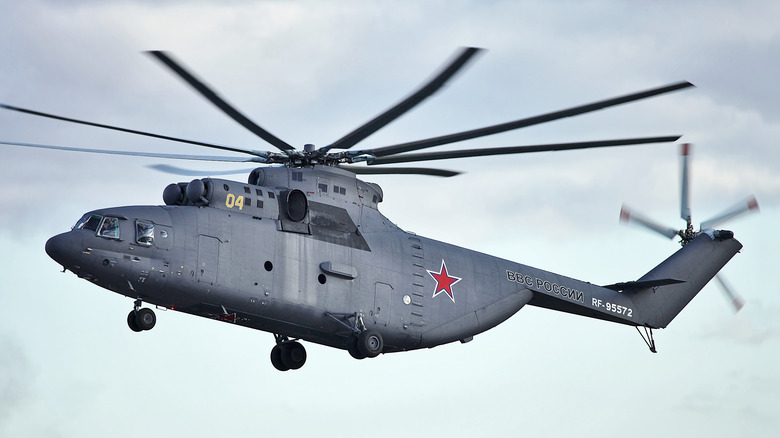Who Makes Mil Helicopters And Where Are They Produced?
It may be surprising to some to find out that the most produced helicopter in the world isn't the Bell UH-1 Huey or the Sikorsky Black Hawk, but the Russian-built Mil Mi-8 helicopter. To date, over 17,000 of this model have been produced since it first flew in 1961, and this is a number that continues to grow as the aircraft is still in production today.
The history of Mil Helicopters stretches back further than its most iconic model, though. In 1947, the then Soviet Union granted Mikhail Mil his own design bureau, a move that represented the birth of Mil Helicopters. A mere year on, and the first prototype — the Mi-1 — was flying. The helicopter was in production by 1951 and made its first public appearance in the Tushino Air Display of the same year.
However, Mil wasn't the only player in town. A second helicopter design bureau, the Kamov Design Bureau, was founded the following year. In 2017, the two design bureaus — along with five assembly plants and maintenance centers — were merged to form Russian Helicopters. In turn, Russian Helicopters is part of State Corporation Rostec, a state-owned industrial giant that employs over half a million people across over 700 companies and produces everything from the aforementioned helicopters to Kalashnikov rifles.
Mil Helicopters are manufactured in several facilities, including Kazan Helicopters, one of the largest helicopter manufacturers in the world, and the factory that has produced over 11,000 Mi-8 helicopters. Let's have a closer look at the company behind the world's most produced helicopter.
Where are Mil helicopters built?
While the merger deliberately allowed both Mil and Kamov to retain a brand identity, the design of future helicopters was placed under a single "Mil & Kamov" design bureau called the National Helicopter Center. The story is different when we look at the manufacturing plants, which tend to specialize in either Mil or Kamov. In the case of Mil Helicopters, there are three key production facilities — the aforementioned Kazan Plant, Rostvertol, and the Ulan-Ude Aviation Plant.
As well as producing the Mi-8, the Kazan Plant also manufactures an Mi-17 variant of the same helicopter, and the Mi-38 helicopter. The Rostvertol Plant manufactures three Mil helicopter models: the Mi-26 Series, the Mi-35M, and the Mi-28NE Night Hunter. Finally, the seemingly ubiquitous Mi-8, and its Mi-17 variant, are also manufactured at the Ulan-Ude Aviation Plant. The facility also provides modernization services for the current fleet.
Separating what market share Mil has under the "Russian Helicopter" banner is difficult. But Russian Helicopters has a perhaps unsurprising 90 percent share of the domestic market. It has also commissioned over 8,000 aircraft since its inception and exported helicopters to over 100 countries. Making it and Mil a major global player in the helicopter market, although current engine shortages are curtailing the export market.
Key Mil Helicopter models
As well as being responsible for the most produced helicopter in the world, Mil also manufactures the largest military helicopter in the world — the gigantic Mil Mi-26. This helicopter can carry up to 90 soldiers or mixed cargoes up to its maximum carrying capacity of 44,000 pounds. Although primarily a military machine, it is also widely used in civilian applications. The helicopter achieves its impressive lifting capacity thanks to its eight main rotor blades and PD-8V turboshaft engines.
The company is also renowned for its attack helicopters. The Mi-24 was a hybrid mix of troop carrier and serious firepower, and was commonly known as the "Hind." Its successor, the Mi-28NE Night Hunter, is more of a true attack helicopter with the capability to perform day-and-night operations and is considered one of the top attack helicopters ever used in war. It features an advanced avionics suite, armor protection, and can carry an array of weapons along with an integrated 30 mm cannon, making it capable of engaging both ground and aerial targets.
Meanwhile, the Mi-8 remains one of the world's most successful helicopters, despite being in service for over sixty years. This helicopter, more than any other, stands as a testament to the engineering skill of Mikhail Mil, a true legend of the helicopter industry.


